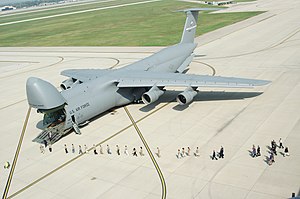Anchelli Atlas: Difference between revisions
Jump to navigation
Jump to search
old>Belfras (Created page with "{{WIP}} {|{{Infobox aircraft begin |name= Anchelli Atlas |image= File:C5 galaxy.jpg|300px |caption= }}{{Infobox aircraft type |type= Strategic airlifter |manufacturer= |des...") |
Ozycaevias (talk | contribs) m (1 revision imported) |
Latest revision as of 19:32, 2 March 2019
This article is incomplete because it is pending further input from participants, or it is a work-in-progress by one author. Please comment on this article's talk page to share your input, comments and questions. Note: To contribute to this article, you may need to seek help from the author(s) of this page. |
| Anchelli Atlas | |
|---|---|

| |
| Role | Strategic airlifter |
| Designer | Anchelli Aerodynamics |
| First flight | 28 July 1968 |
| Introduction | 4 August 1971 |
| Status | In service |
| Primary user | Belfrasian Air Force See Operators |
The Anchelli Aerodynamics Atlas is a heavy cargo transport aircraft designed to provide strategic airlift capability for the deployment and supply of military forces across the world. The Atlas is capable of carrying outsize or oversize loads and is one of the largest military aircraft in the world.
Design
Variants
- Atlas C.1
- Original version of the Atlas operated from 1970 to 1977 until the C.1A was introduced. As of 2003 all C.1 variants of the Atlas have been decommissioned.
- Atlas C.1A
- Updated platform of the C.1, featuring a redesigned wing structure to remove cracks appearing after extended service that endangered lives of crew and personnel aboard. New wing designs also opened up space for increased fuel capacity, allowing for a further one and a half hours of flight time.
- Atlas C.2
- An improved version of the Atlas first produced in 1992. Further improvements to the wings were made along with a simplified landing gear system that drastically reduced maintenance time. Updated turbofan engines were installed and the avionics system was completely overhauled.
- Atlas C.2A
- A limited variant modified from the C.2 that featured significantly larger internal cargo areas. Five examples of the C.2 were modified to the C.2A standard to allow for the mobility of larger payloads. This was achieved by removing rear passenger compartments, redesigning the rear cargo door and moving the aft bulkhead further to the rear. Other modifications included multiple power outlets within the cargo hold to power cargo if required and external outlet/inlets for the aircraft to transfer power from an external source to internally held cargo as needed. Only five aircraft were modified to the C.2A standard and are permanently on loan to STAR.
- Atlas C.3
- Limited life run of the Atlas that attempted to merge C.2A modifications with regular service requirements. Two versions were modified from C.2 airframes but failed to meet requirements for quick turn-arounds.
- Atlas C.4
- Following an aggressive modernisation scheme, all C.2 airframes were modified to the new C.4 standard. Avionics were updated to meet new standards, improving global communications, flat glass architecture displays and new safety equipment. Further updates included new cargo holding systems that eased tie-down duties, new engines that drastically improved performance.
- Atlas C.4A
- An improvement of the C.4 that was brought into service during retrofits to the existing fleet and subsequently all models were refitted to meet the new standard. Updates include lighter airframe skin that provided longer maintenance life, improved tire design and new pressurisation systems for the cockpit and cargo areas.
- Atlas C.4B
- An updated variant of the C.2A for service with STAR. The five C.2A examples were refitted to the C.4B standard in 2005
Foreign variants
Operators
Specifications
<imgur thumb="yes" w="300" comment="Schematic view of the Atlas.">RqbIvPZ.jpg</imgur> General characteristics
- Crew:
- 7 nominal (2 pilots, 2 flight engineers, 3 loadmasters)
- 4 minimum (2 pilots, 2 flight engineers)
- 7 nominal (2 pilots, 2 flight engineers, 3 loadmasters)
- Capacity:
- Upper deck area capable of holding personnel only capable of holding:
- Forward upper deck area capable of accommodating 15 people plus relief crew
- Rear upper deck area capable of accommodating 75 troops or a kitchen/relief area for long-haul flights
- Forward upper deck area capable of accommodating 15 people plus relief crew
- Lower deck area capable of being loaded from front and rear ramps capable of holding:
- Upper deck area capable of holding personnel only capable of holding:
- Length: 75.31 m (247.1 ft) ()
- Wingspan: 67.89 m (222.7 ft) ()
- Height: 19.84 m (65.1 ft) ()
- Empty weight: 172,371 kg (380,013 lb) ()
- Max. takeoff weight: 418,000 kg (922,000 lb) ()
- Powerplant: 4 × Augment-Rheyling 51000 turbofans
Performance
- Maximum speed: 531 mph (855 km/h)
- Range: 6,329.287 mi (10,186.000 km) with 129,000 kg (284,000 lb) payload ()
- Service ceiling: 41,000 ft (11,850 m)
